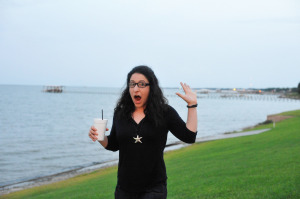by Sam Tackeff | Jul 1, 2015 | Books, Books in 2015
It’s a wet travel day on my way to Texas, and while I’ve finally arrived in the Lone Star State, unfortunately, I’ve arrived in the wrong city, and we’re currently sitting outside the gate waiting for a new pilot to get us from Austin to Houston. I spent a good long while chuckling as the gate manager has been ever so politely dealing with my fellow passengers, but there are oh so many times you can listen to someone say “I’m sorry ma’am, I really can’t control the weather,” and then continue to get berated by a irate traveler without starting to feel a little crazy yourself. So I thought this would be a good time to talk to you about some of the great books I’ve been reading lately!

At the end of the month I finished an early galley copy of Jess Fechtor’s Stir, and last night I had the pleasure of attending her spectacular author event at the Harvard Bookstore.
I’ve been reading her blog Sweet Amandine for nearly as long as I’ve been writing at The Second Lunch. We started writing the same month in 2009, albeit for very different reasons. I was feeling very lonely in my new city, San Francisco, and she was finding something to do after a devastating brain aneurism left her very, very sick. Of course, I didn’t know that at the time that I started reading her blog, and it wouldn’t be until much later that she started sharing more with the world. (Incidentally, I started reading her new blog in 2009 because she was writing about food from Boston, and I missed New England. It’s been delightful seeing this book come into fruition!)
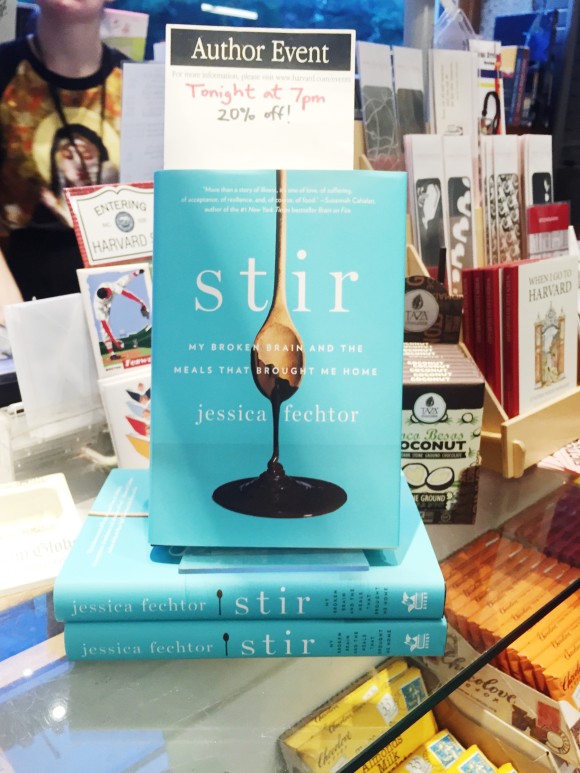
Her book, which I worked through in one whirlwind sitting (I didn’t get up for five hours) is spectacular. Beautifully written, will make you cry, AND there are recipes! Go read it!
I’d also like to say that as a book lover, the amount of people who came to this event gave me ALL of the warm and fuzzies. But duly deserved, because Jess is just as lovely in real life as she is on the Internet.
West Coast friends! She’ll be speaking at Omnivore Books on July 16th! Go!
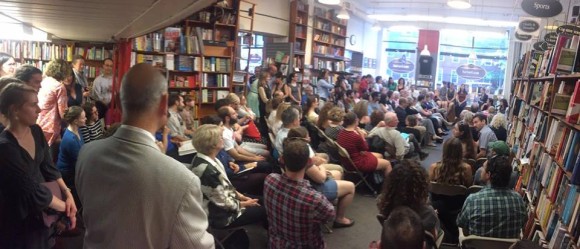
In Fiction, I just recently finished The Storied Life of A.J. Fikry, another book that I’d held off on for absolutely no reason other than I thought that the popular obsession couldn’t possibly be warranted. I was wrong. It’s a great book!
A few other titles on my bookshelf include Americanah, and Jonathan Galassi’s Muse.
And of course by the end of this travel debacle, I’ll likely have finished the ENTIRE 530 pages of All The Light We Cannot See. I’m on page 363, and I started this morning after take off, after picking it up on a whim for David Leite’s new book club. I had absolutely no idea what the book was about before starting, and it hooked me from the first 10 pages.
What are you reading?
by Sam Tackeff | Jan 29, 2011 | Baking, Challenge, Cookies, omnivore books
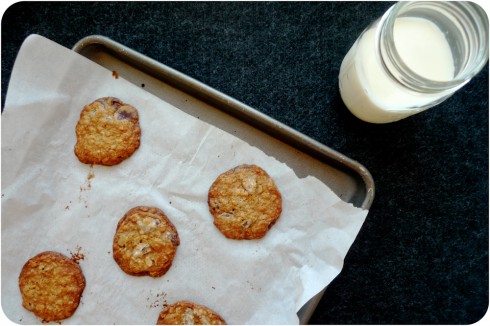
Hint To Self #324: If you are hosting a cookie competition, there is no way in hell that you will not eat dozens of delicious cookies. Your plan of 3-5 cookie samples is an outrageous underestimation of the truth, and a lie to yourself. You’ve learned this at countless previous competitions. Plan accordingly.
But, before I re-cap the hardcore competition (yeehaw!), I want to take a quick moment of reflection. Today, a reader who shall go nameless, actually apologized for commenting so often on my blog, and let me know that she hoped I didn’t think she was crazy. This actually made me a little sad, because it couldn’t be farther from the truth. I can’t thank you all enough for coming and reading my blog. The reality is, every time I read a comment, my heart fills with joy. And yes, that even goes for my mom, who I know has been reading every single post dutifully since the beginning.
My first attempts at blogging as a teenager were a personal pursuit. Nobody actually read my LiveJournal, and I was okay with that. I started writing this blog though because I missed my family, my home, my community, and food. It was a scattered attempt to find my place in this world, to share my experiences and to exist within a community of like-minded folks that I so admire. Over the past few years, it has been truly miraculous to meet so many wonderful people because of this blog, and while working at Omnivore Books. You’ve all made my life so much greater for it, and again, I thank you.
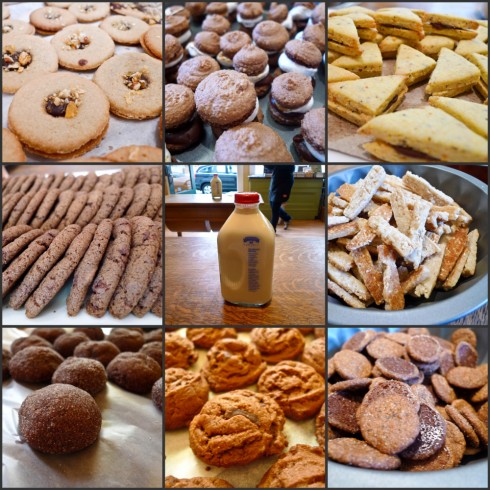
Off my sentimental soapbox for a bit, it’s time for another competition round-up from our little corner of the world at Omnivore Books on Food! We’ve had pies, fried chicken, pumpkin recipes, tomato recipes to name a few. This time, with cookies, I think we truly took it to another level.
Now, if you know me personally, you know my love for cookies runs deep. I can tell you that it is exactly an 11 minute walk to Anthony’s Cookies from Omnivore Books. When I test a new cookbook, if they have an oatmeal chocolate chip recipe, you can be sure that I’ll make it. (Mad Hungry is in the lead – see the top cookie shot there). If you are ever in the area near Brown University, you need to make a pit stop for a Meeting Street cookie, which a friend of mine once admitted that if she could, she would pro-create with one. Her grandmother, incidentally, makes a peanut butter cookie that rivals all others. And if you are ever able to make it to Big Sur Bakery, Michelle’s chocolate chocolate chocolate cookies are glorious, as are all of the varieties.
I share this all with you, because, being cookie obsessed I hold very high standards, and today I was very impressed. There was a real breadth of entries in this competition. I’m missing about five here, because in the end we sort of just exploded with cookies.
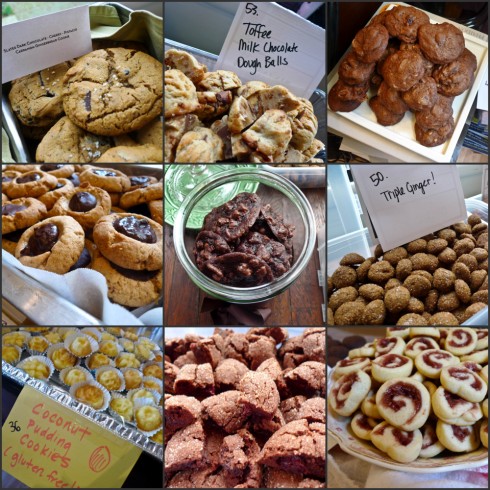
In no particular order:
Brown Sugar Toffee, Chocolate Chip, Chewy Almond Raspberry, Jacques Torres Spiced Chocolate Sugar Cookies, Orange Polenta, Chai White Chocolate Shortbread, Macadamia White Chocolate Chip, Caramel Cashew Choc-Oat-Ban, Toasted Walnut, Crispy Spicy Gingerbread Coins, S’more Macarons, Mayan Mexican Chocolate, Crispy Sesame Sticks, Chocolate Peanut Butter Sandwiches, Sugar Babies, Coconut Bars, Chocolate No-Bake Cookies, Chocolate Peanut Butter Fudge-gasms, Double Chocolate Mint, Cranberry Orange Pecan Oat, Coconut Pudding (gluten free!), Mocha Shortbread Chocolate, Salted Caramel Whoopie, Pecan Thumbprints, Raspberry Coconut Swirls, Mocha Squares, Chocolate Pecan Cherry, Mexican Hot Chocolate, Chewy Quinoa Raisin, Lemon Ricotta, Uncle Bill’s Cookies, Chocolate Spiced Cherry, Chocolate Chocolate, Double Chocolate Cherry Toffee, Chocolate Espresso, Triple Ginger, Lavender Shortbread, Salted Peanut Butter Triple Chocolate, Salted Chocolate Cherry Pistachio Cardamom, Toffee Milk Chocolate Dough Balls, Lemon Rosemary, Almond Butter, Cowboy Cookies, Oatmeal Chocolate Chip, Monster Cookies, Peanut Butter Chocolate Chip, Perfect Chocolate Chip, Sable with Black Tea and Plum Jam, and Chocolate Toffee with Sea Salt.
I was happy to see so many people I know, and meet lots of new folks as well. (A quick shout out here to Irvin whose wonderful blog Eat The Love just got a nod from Saveur because he is a rockstar!!! And, because I met her for the first time last week, one to Annie the Baker, whose dough balls are the stuff of legend.)
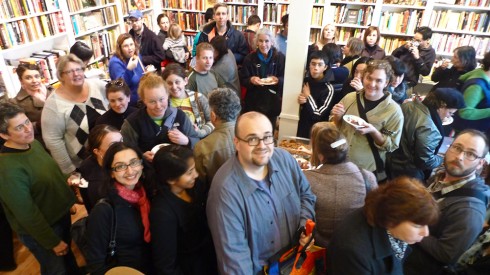
The second place winner – who in my post-sugar-coma I neglected to write down her name – won for her Salted Peanut Butter Triple Chocolate Cookies. As I started tallying the votes, I realized that I hadn’t tried one of these yet, and they were heading clearly to the lead. I’m glad that I snagged one before they were all gone! For her success, she won a coveted year long membership to The Bakers Dozen.
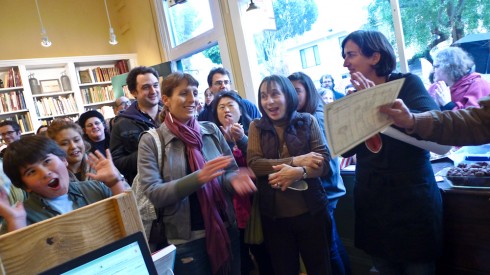
The winner, Julie Wise, won $150, with her Chocolate Toffee Cookies with Sea Salt. She entered the contest at the urging of her son, and is donating the winnings to his school, Mira Loma! So, pretty much, she also deserves an award in the coolest mom category.
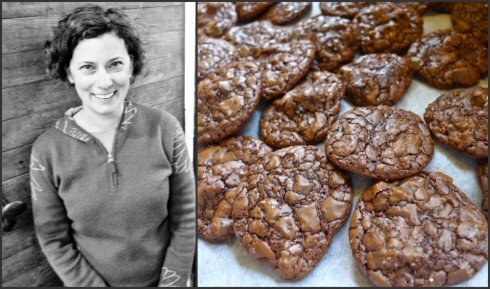
Here is the winning recipe! Now I’m headed to sleep off the sugar coma. Celia, I believe, is a better woman than I, and last I checked twitter is heading to IN-N-OUT. That is dedication people. Have a great rest of the weekend everyone!
Chocolate Toffee Cookies
Adapted from Smitten Kitchen, where it was adapted from Bon Appetit
* * *
1/2 cup all purpose flour
1 teaspoon baking powder
1/2 teaspoon salt
1 pound bittersweet or semisweet chocolate, chopped
1/4 cup (1/2 stick) unsalted butter
1 3/4 cups (packed) brown sugar
4 large eggs
1 tablespoon vanilla extract
5 1.4-ounce chocolate-covered English toffee bars (such as Heath), coarsely chopped
1 cup walnuts, toasted, chopped
Flaky sea salt for sprinkling (optional)
Combine flour, baking powder and salt in small bowl; whisk to blend. Stir chocolate and butter in top of double boiler set over simmering water until melted and smooth. Remove from over water. Cool mixture to lukewarm.
Using electric mixer, beat sugar and eggs in bowl until thick, about 5 minutes. Beat in chocolate mixture and vanilla.
Stir in flour mixture, then toffee and nuts. Chill batter until firm, about 45 minutes.
Preheat oven to 350°F. Line 2 large baking sheets with parchment or waxed paper. Drop batter by spoonfuls onto sheets, spacing two inches apart. Sprinkle with a pinch of flaky sea salt, if you’re using it. Bake just until tops are dry and cracked but cookies are still soft to touch, about 10 to 13 minutes. Cool on sheets. (Can be made 2 days ahead. Store airtight at room temperature.)
by Sam Tackeff | Dec 11, 2010 | Baking, Books, Chocolate, Cookies
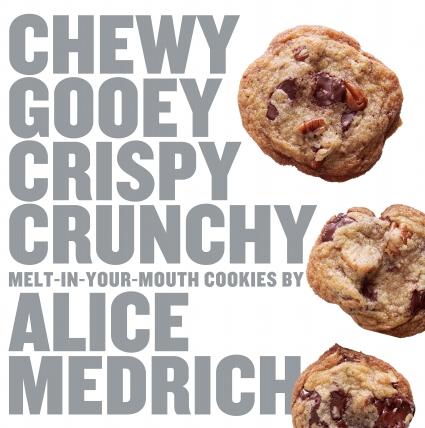
There are some cookbooks I read at the shop and fall madly in love with, but refuse to take home until I can no longer resist them because I know that I’m doomed when I do. Doomed! [Don’t worry, they win out at the end, I assure you.] Alice Medrich’s ‘Chewy Gooey Crispy Crunchy Melt-In-Your-Mouth Cookies‘ is one of those books.
This is because if there is any problem worse than my “cook-book problem”, it is my “cook-ie problem”. I am the type of person who will eat an entire batch of cookies if proper safeguarding precautions are not taken. And, as I’ve been giving in a little too often to my cookie problem, the one pair of jeans that I can still fit into are threatening to burst. I’m holding out as long as I can, damn it.
Alice came to Omnivore to talk about the book, and after spending a whole hour with the Goddess of Chocolate, it has taken every effort of mine not to bring it home and immediately start baking. My resolve was even further weakened by actually eating cookies made from the book:
For the talk, Celia made her Alfajores, a sweet and slightly crispy Latin American cookie filled generously with dulce de leche. Crispy and Gooey? Yes, please! She tweaked the recipe slightly to add some nuts and a little bit of extra salt. I had four, and would have had more had my mother not ingrained the principle of sharing. This was difficult. Had I been only a *slightly more selfish* and greedy person, there would have been none left in minutes.
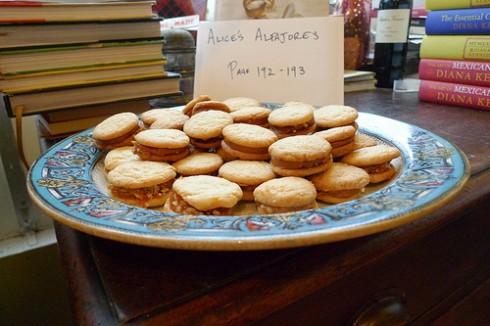
A few reasons why you need this book:
1. It’s by Alice Medrich. **(see below)
2. The broad organization. The book is a play on textures and flavors. You get to choose from Crispy, Crunchy, Chunky, Chewy, Gooey, Flaky, and Melt in your mouth. Alice Medrich is a “crispy” girl. I’m a “chunky” girl myself. Yes, I said that. The more chocolate hunks or nuts, the better.
3. It’s all in the details. “Cookies seem deceptively simple. But success with cookies is success in the details,” Alice noted. When you give the same recipe to ten cookie bakers, even experienced ones, you might just come out with ten completely different versions.
This book seeks to streamline your baking. If you can conquer at least some of the variables, you will make better cookies. A user’s guide, quick start, FAQ’s, ingredients, equipment, are all there to make cooking baking more precise and successful.
The quick start gives the five most important details about successful cooking baking: amounts of flour, types of flour, oven temperatures, preheating the oven, and types of baking sheets. The FAQ’s go into even more detail about basic ideas: how to toast nuts, why you would chill cookie dough, what the best way to flatten dough, etc.
And yes, Alice Medrich wants you to get a scale. (And so do I. I got mine at Ikea for 12 dollars. What are you waiting for?) The measurements in the book are also in cups, but using a scale will give you great, consistent results.
4. The “Smart Search”. Even better than just an index, there is a brilliant section called the “smart search”. Need Wheat-free cookies? She lists the 40 or so options for you. Whole-Grains? Dairy-free? Ditto. Ridiculously Quick and Easy? Same. Don’t have time to bake during the holiday season? Well, there’s a whole list of ‘Doughs that Freeze Well’ and ‘Cookies that Keep At Least 2 Weeks’. Yes, there are even low-fat. Although, I’ve become wise to understand that low-fat doesn’t in any way mean that you should eat the whole batch.
5. Simplicity. After 8 cookbooks, things are getting more do-able for the home-cook. That doesn’t mean that she skimped on the fun stuff. “Anything I do, I need to learn something, and I need to teach something,” Medrich says. There are classics, and new twists on old favorites. “I didn’t want it to be something that an ordinary home baker with kids wouldn’t want to pick up and bake from”.
6. Well tested recipes. If you are familiar with any of her older cookbooks, including her IACP winning book ‘BitterSweet‘ you know first hand that her recipes work. When she wrote her first cookbook, she did a huge series of ‘Side-by-Side’ testing in a kitchen with a friend to compare how they interpreted the written recipes, and tweak to get more consistent results. (A fairly genius idea.)
Medrich also teaches cooking classes. “The teaching helps, because I do the recipes and get to see what questions come up.” Teaching is also useful to help a recipe writer guide the reader in the recipes. Learning how people interpret words on the page teaches her to be a better writer and learn to use more specific explanations. And the difficult part of testing? “First, too much tasting, and second, knowing when to stop.”
7. Well written recipes. Often, recipes take for granted things that are intuitive if you’ve had a lot of practice in the kitchen, and the author forgets to write down steps that the novice might not yet know. When you read through any of Alice Medrich’s recipes, it’s like you have a perceptive friend guiding you through things, so you don’t forget the basics while under fire.
It was rumored that Julia Child once said to Flo Braker “Write what works for you, Dearie”, and Medrich re-emphasizes that. “The good writers are the ones who ignore how it’s always been done and explain it in a way that makes sense to them.”
8. The personal touch. Alice has been on the set since book one cooking and styling her own dishes for the photo shoots. (For those less familiar with cookbook production, this is rarely the case). “It’s the thrilling part of the process in this book!” she said.
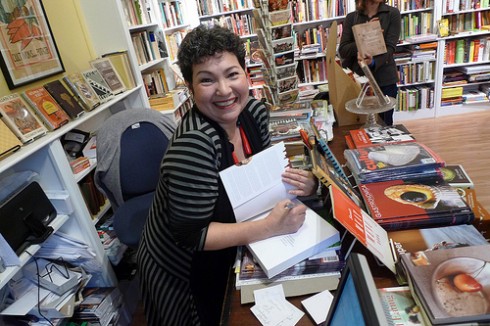
** While it’s important to focus on the merits of the cookbook itself, I take great pleasure in knowing the history of cookbook authors. It sweetens the deal when you get to use a book written by an inspirational (and smiling!) woman like Alice Medrich.
The Backstory:
When Alice Medrich was twenty, she went to Paris. It was there that Mme. Estelle, her land-lady, taught her about the Truffle, “that smooth, bittersweet statement about chocolate” that unbeknownst to her, would lead her to great things.
Upon coming back to Berkeley, her future still unclear, she opted for the rational lifestyle choice of putting off the real world… and heading to business school. Given that I almost went to business school right after graduating college, I can understand the impulse. (Though I’m glad I didn’t.)
At business school, she spent her free time making cocoa dusted chocolate truffles for the new Pig-By-The-Tail, Victoria Wise’s charcuterie shop. It didn’t take long to realize that she was becoming more interested in creating a dessert repertoire than dealing with case studies, and soon dropped out of b-school.
Before opening a pastry shop, Medrich did her due diligence. She headed back to Paris to take classes at Lenôtre, the famed pastry school, where she was often the only woman in her pastry classes.
She learned timing, temperature, and the physicality of multiplying recipes by trial-by-fire: at Pig-By-The-Tail, she would come up with a weekly special at the beginning of the week, an elaborate pastry that could be pre-ordered by six lucky customers. Without actually knowing if it would work, Medrich set about learning the recipes as she went – theoretically she would get enough practice by the end of the week to make at least six!
In 1976, she opened her shop, ‘Cocolat’.
I’ve heard more than one Bay Area native wax poetic about Cocolat and moan desperately about Alice’s legendary truffles. Celia (@omnivorebooks) used to head to the shop with cash from her co-workers in each pocket to pick up a bounty on her breaks. Mary (@mcs3000) recalled saving money to buy Alice’s first cookbook and making her Strawberry Carrousel Cake.
As a newcomer to San Francisco, it’s stories about shops like Cocolat that make me regret having not grown up here. By the time I moved here, Cocolat was no longer. (Pig-By-The-Tail, and Fran Gage’s Pâtisserie Française are others that I tragically missed out on.) I can’t live my life dwelling upon the fact that I’ve lived in the wrong era, but stories about the truffles and Cocolat’s ‘Reine de Saba’ make it hard not to. Another good reason for cookbooks like ‘Chewy Gooey” to help keep a legacy alive!
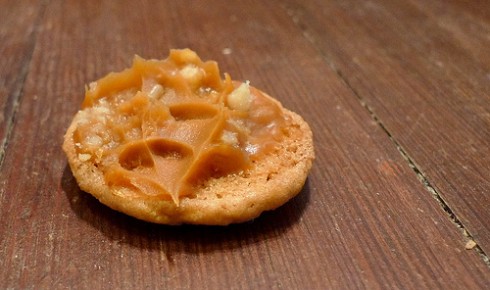
Alice’s Quick Bites:
That’s a lot of chocolate! In the early days, it wasn’t so easy to find quality ingredients. She used to send friends and family to purchase all the Ghiradelli Semisweet chocolate from the supermarkets (the best you could find at the time), until she realized that she used enough to get wholesale. Soon, Fifty pounds of chocolate wasn’t enough, and by the time she opened Cocolat, she was getting 300, even 500 pounds a month of chocolate delivered to her door!
Her favorite baking chocolates? “The most important thing is to use what you like the taste of. I still use Scharfenberger, because I like the taste a lot,” Alice says. (While I love using Valrhona myself, for chocolate chips I use Ghiradelli 60% cacao, which are flatter discs because of a higher fat content.)
Who eats all the recipes she tests? Her neighbors have been next door from her for more than thirty years, and they don’t accept treats anymore. (She fondly remembers the day that they sat down and ate an entire cake together.) Nowadays she gives them to whoever will take them – the new neighbors on the block, the synagogue down the street, a friend’s softball team.
On Inspiration: Inspiration comes from everywhere. Sometimes easily: “A lot of new recipes come from a recipe that is good already rather than a recipe you want to fix.” Other times, more abstractly: “I once developed a recipe from a salad from one of Paula Wolfert’s cookbooks.”
Her next project: Already in the works, a baking book for people more comfortable with cooking than with baking. Recipes that work the way cooks work, with a little bit more flexibility.
Chewy Gooey Crispy Crunchy Melt-in-Your-Mouth Cookies
by Alice Medrich
384 pages
Artisan Books
http://alicemedrich.blogspot.com/
by Sam Tackeff | Oct 16, 2010 | Books, Food Travel, omnivore books
 (photo: Nader Khouri Photography)
(photo: Nader Khouri Photography)
I don’t get star struck. There is something about the notion of being starstruck I find completely absurd. Girls going apoplectic over a 15 year old “hottie”? Waiting for five hours in the broiling sun to get a glimpse of an actor? Or stalking your favorite pop star for that matter? I just don’t get it.
But then again, I’ve been trying to shake the weirdest feeling. One of those feelings where I’ve been run over, had my first kiss, finished a marathon, and won a million dollars… all in the same day. Shit. Is this what being star struck is like? It has been a week since I had the pleasure of hosting René Redzepi here in San Francisco, and I’m still feeling all a quiver.

(Photo: Phaidon Press)
Let’s be clear here, I had no idea what I was getting myself into. With Celia on vacation in Istanbul, I’d been manning the fort at Omnivore for a few weeks. Sure, I had no problem running a few events. Rock Star chefs? I can handle it. No problem Celia!
And then one day it started – a delivery man came with an entire palette of boxes.
Inside? The Noma Cookbook. 1300 pounds of the Noma cookbook, to be exact. It’s an obscenely beautiful book, put out by Phaidon, weighs nearly five pounds, and is covered in gray cloth. Three quarters of the book are striking photos of the gastronomic creations that have catapulted René Redzepi’s Noma to stardom; this year, Noma has been named the best restaurant in the world.

(photo: Nader Khouri Photography)
On Sunday night, I couldn’t sleep. Thinking about the Monday lineup was exhausting. A three o’clock signing at the bookstore, close up shop, take all the books and head over to Delancey Street Theater for a two hour talk with Redzepi and Daniel Patterson, check people in, sell books. Racing thoughts kept me awake, terrified. What if I can’t handle it? What if we screw up? What if someone has broken into the bookstore and stolen all 1300 pounds of books — a serious fear brought on by my sleepless delirium.
In hindsight, of course, I had nothing to worry about.
What can I tell you about René Redzepi?
In only a few hours I was able to unequivocally deduce that he is one of the most gracious, intelligent, driven people I have met. (He also has a voracious appetite for knowledge, and snagged some of my favorite historical books on food, including rare copies of Jane Grigson’s Vegetable Book and Fruit Book, and Marinetti’s The Futurist Cookbook.) He took the time to sign and personalize every book, take pictures with adoring fans, and joke around in between. And he’s adorable.
When he spoke, I took notes – 12 pages of notes – which I’m going to do my best to recount without sounding like a rambling idiot.

René Redzepi and Daniel Patterson Do Stand Up
What happens when you get two chefs on stage together and a captive audience of 150 people? Somehow, they both managed to utter the phrase Seal-Fuckers and everyone finds it hilarious.
For two hours, what unfolded on stage was something incredible. Something I believe everyone will be thinking about for years to come. A combination of a comedy routine, storytelling, and critical analysis. I think it’s safe to say the audience was thoroughly moved by the presentation.
In his introduction, Daniel Patterson – of Coi in San Francisco and the newly opened Plum in Oakland – was clearly excited to be sharing the stage with Redzepi. And who wouldn’t be, really?
Patterson described Redzepi as the master of “cooking from your own place”, and extolled what makes him the best in the kitchen: “Intuition – he’s a scary good cook. Super distinctive and sharp. Watching his mind work? So, so, fast.” To be a chef of this caliber, it is not just about skill, it’s also something deeper. “There’s an incredible warmth, a very strong emotional foundation. There is real joy.”
As the talk commenced, the audience was instructed to look through a little cloth bag under each seat filled with freshly foraged herbs, hay, and a small packet of Angelica root (known in Chinese medicine as Dong Quai). As you opened the bag, fragrance exploded and you were instantly transported to the forest. The bag was so fragrant, in fact, that after leaving it overnight in my leather purse, I’m beginning to believe it has permanently scented my handbag.
It Starts In Childhood
Some of Redzepi’s earliest influences were from an upbringing spent traveling between Denmark and his father’s native country, Macedonia.
In Macedonia, if you wanted food, you grew it. And what you didn’t grow, you traded with your neighbors, or perhaps picked up at the baker. Driven mostly by poverty, but also a sense of pride in their own food, life there was back to the land. The people were poor but not wanting in good food.
It’s not surprising to hear Redzepi didn’t drink soda until he was an adult. Special drinks were syrup over rose petals, or milk (provided that you milked the cow), but mostly, there was water.
In contrast, Denmark in the 1980’s was captivated with the microwave and ready meals. As a child, Redzepi recalled some embarrassment about heading to Macedonia (particularly while his Danish peers were off spending their summers in Italy or France). In hindsight, experiences foraging, farming, and eating from the land have only served him well. His family grew peppers and watermelon. Watermelon, he joked, is the perfect food:”You eat, you drink, and you wash your face”.
But good things don’t last forever, Redzepi lamented, “when the war came, people fled, and slowly as they have returned, life in Macedonia has become more Westernized. They used to sit on the floor, eat with fingers from platters of food as a family, and everything was cooked.” But that is no longer true, and as we are seeing all over the globe, cultural legacies are being lost.
Education Leading up to Noma
When he entered chef college, he became instantly smitten by cuisine. Originally, Redzepi assumed he was going to do his version of French food, but then he went to stage at El Bulli in ’98 – and ’98-2002 was a great time for the restaurant. “For me, I left that place with such a sense of freedom.” From there, he headed West to California for a stage at French Laundry.
At French Laundry, he was further energized. Here was a great Chef [Thomas Keller] with such a strong signature – “An American chef doing something American”, with ingenious dishes like “Coffee and Donuts”.
After traveling the world, the passion to do something new, unique, really something uniquely Danish, was solidified.
And so, seven years ago, he opened his first restaurant, Noma. He was 25.

Noma is located in the Christianshavn area of Copenhagen, Denmark. The building’s original use was as a warehouse for North Atlantic imports, and the rooms that the restaurant is housed in were used to store salt. The owners wanted a chef whose cuisine could in some way reflect the history of the place. And so, Noma moved in, with a noble goal of creating “high gastronomical cuisine using what was around us.”
At the time, basically all top level restaurants in Denmark were using European products. It was the standard. There was such a disbelief in the project. “It’s amazing how little faith we ourselves, the people, had in our own products.”
What unfolded was what Redzepi described by quoting Schopenhauer: “All truth passes through three stages. First, it is ridiculed. Second, it is violently opposed. Third, it is accepted as being self-evident.” (Yes, the only chef I’ve heard quoting German philosophers.)
To put things in perspective about how hard they worked, Redzepi wasn’t happy even receiving their first Michelin star within a year of opening the restaurant. “At first, there were still too many reference points from other cuisines.” The idea of being local is easy. The difficult part is how you take “local” on the plate and make it work.
And so they started seven years ago rediscovering ingredients “so that they taste of their own place”. Chefs often read a lot of recipe books to draw inspiration, but Redzepi found that he needed to start reading other books – history books – to learn what people ate over the ages. And he spent a lot of time talking to historians.
As we listened to Redzepi describe this, Patterson shook his head in admiration: “There is a determination – Rene works a lot. He’s worked his ass off for years. There is a constant pushing.” To which Redzepi replied: “If you don’t have patience and commitment to the extreme and are not manic in your pursuit for this, it can’t happen. You have to work for this.”

Five Dishes
At this point, although I could have listened to hours of just conversation, we got to see a video of five dishes with notes from nature to plate. Most of the dishes at Noma are created with nature as the direct influence. Redzepi explains: “A lot of people ask “why is it so landscape-y?” It’s a reflection of where we go, walk, live….this is just the way things have shaped.”
The cuisine at Noma is so dependent on the weather and the seasons, it can change every day.
Redzepi began by introducing the ingredients he works with: “In Denmark, if there is any prejudice against our region, it’s that it is extremely cold and people think no ingredients can grow. But it’s a matter of determination and hard work.”
Taste is integrally linked to place. He explained (without prejudice) that things in America taste almost overly sweet to his palate – which happens to be because produce here has so much more time in the sun, than in Denmark where the flavors are much more mineralized because the plant gets nutrients mostly from the ground in their harsher climate.
Each dish has its own story, and unfolds with whim and novelty.
There was ‘Asparagus and Spruce’, where the green asparagus tips are grilled, then juiced. They add a touch of spruce oil, and then wrap white asparagus around actual spruce leaves, top with the juiced asparagus, and add a touch of whipped cream.
Or the ‘Steamed Oyster’, composed of the oyster, as well as plants sourced from the land around the oyster flats. So you have these native oysters, and then unripe pickled elderberry, and the dish is created by pouring seawater on, and steaming it in almost its natural environment.
Or “The Sea”, where a dish is composed from sea herbs rich in vitamins, sea water, rocks and beach plants. Topped with dried shaved urchin roe, arranged as if they were in their natural environment.
Or the ‘Hen and the Egg’, where the chef thinks what is a chicken? The whole dish is created from a starting point (the hen house) and the meal is created completely from ingredients a few feet around it. The egg, the hay from the coop, the herbs the hen eats. And then the whole dish is interactive – the diner actually puts together the dish and eats it.

My favorite dish however, was the ‘Vintage Carrot’, because it truly reflected the essence of the creativity on display at Noma.
A vintage carrot is actually a vintage ingredient.
They were having a winter like Ragnarök (the Norse mythological version of Armageddon), and it was “so crazy cold”. The chefs were running out of things to cook at Noma, and were desperately working with their farmers to find something they could serve. One farmer had these old hideous carrots he had left in the ground for a winter, and then stored them in his larder. They were year and a half old carrots. So they thought to themselves, how would you cook a carrot like this?
Maybe like you would cook a piece of perfectly aged beef – with as much care as possible. “So we wanted to do that with a carrot. What would happen if we gave the same care to a shitty old carrot?”
And so here is this dish, composed of vintage carrots, gently cooked with wild chamomile and sorrel in goats’ butter. They cook it, very slowly, an hour, hour and a half, and then suddenly it’s the carrot of their dreams.
And then he thought: SHIT. What if we are now eating the wrong carrots? What if this was the RIGHT carrot? The way carrots are supposed to be? The authentic carrot?
“So we asked the farmer – what other old shit do you have? Give us your crap! And then he got us vintage potatoes…” so the story goes.
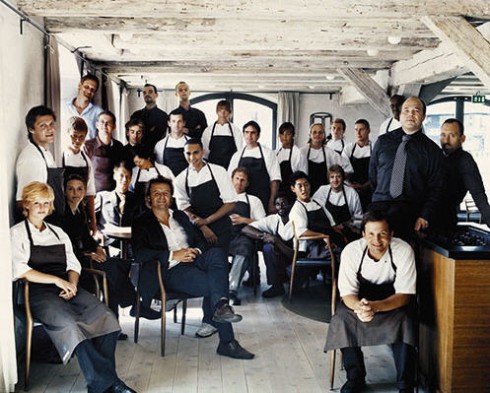
CONVERSATION AS THE FOUNDATION
“The importance of people and the importance of conversation is just about everything for us.”
After fully transfixing us with food, the conversation returned to the work they put into the restaurant. Possibly the only frustration I have with the Noma book is that the front section on the day to day happenings of the restaurant is only a handful of pages. (Maybe that’ll be the next book.) Listening to Redzepi, these details are clearly things that he has thought long and hard about.
Noma has 20 full time employees, and 5-8 stagiers (interns – for one to three months) at any time, and the empowerment of each and every team member is an integral part of Noma’s success. The work is highly technical, and many people are involved in each and every dish. All this for forty covers a night. “The kitchen is full of good people, free thinking people – people who take standpoints on what they are cooking,” he went on. “Our trade is one of the last trades that will never be replaced by machines… you need to think”.
In addition to the hard working kitchen staff, they also work hand in hand with the farmers. Noma has a large network of farmers and foragers. They worked hard to cultivate these relationships. Just by giving feedback and respect to the farmers (a group of people, on the whole rarely congratulated for their hard work), they found these people striving to do better. “There is a sous chef in the kitchen to make sure the farmers feel that they are a part of us… They get Christmas cards every year, and every year they are invited to eat at the restaurant. We are having so many conversations with them constantly. If these people were not on the team, we wouldn’t have a restaurant.”
To further the education of his kitchen, Redzepi detailed several ways to make a better chef:
1. Make them harvest, prep, cook & serve. (Instill the feeling of giving.)
Each of the staff at Noma are taught to forage and harvest, which changed how the kitchen thinks about food. Chefs are usually trained to work within the format of recipes, but Redzepi knows first hand that chefs start changing when they really know how things grow. There is something so important about the conversation in nature, “I know it sounds a bit wacky,” Redzepi chuckled, “[but you need to have] a conversation with the plants in the forest. There is something so valuable about learning the essence of taste from the source in its perfect element. You know, the way it should be. How much would you allow yourself to do with this ingredient? [This] reflects how you treat an ingredient in the kitchen.”
How can a restaurant have the same feeling of giving if they charge for their meals? The chef was quick to make note that “in a perfect world, all restaurants would be free”, which he amended: “In a perfect world, all restaurants would be subsidized by the government.” [The audience laughed.]
By requiring everyone to have the opportunity to serve, you create better chefs. Actually seeing guests, they take a better standpoint on cooking. It’s the feeling you get as a parent feeding a child – you want to provide the best and most healthy and perfect food – they adopt the same philosophy for their diners.
2. Every Saturday they have an innovation practice in the kitchen, after service (about 2 am). Everyone has worked 75-80 hours or more. Each section has a head chef who creates a dish – the purpose is to “make chefs take a standpoint on what they enjoy about food.” In the beginning, it is very difficult – but week by week – people get better, stronger. They start really developing themselves as chefs.
This is one of the many reasons chefs around the world fight to work in Redzepi’s kitchen.
* * *
As the conversation neared its close, a member of the audience asked Redzepi “What’s next?” to which he replied:
“The biggest joy is now having complete freedom to cook what we want.” Redzepi laughed, “If we want to put reindeer balls… or beaver snout… we could put it on the menu, and people will try it.” Next is the same… until there is no more inspiration. “I have a personal vision of keeping learning throughout my life, and keeping my family learning.”
“Year by year, season by season, you start to understand more, and it starts adding up.”
* * *
As people filed out of the theater, my admiration was only reaffirmed, as René stood next to me while I sold books, and he personalized them, chatted, posed for photos, and put a smile on peoples’ faces.
Am I star struck? Maybe. A little. But, I’d like to think my jitters came from experiencing a critical moment – one where I was forced to think hard about what I had thought was true. I had to accept something new and profound. After seeing someone with so much passion, dedication, and thoughtfulness, a small part of me regrets not becoming a chef. But for now, I’m taking the time to think about what this will all mean for me. Who knows where life will take me?
And so, here, I share one slightly embarrassing photo that Emily took of us, (give me a break, I’d been working like a fiend the entire day), and would like to take a moment to say thank you to everyone who made this day possible.
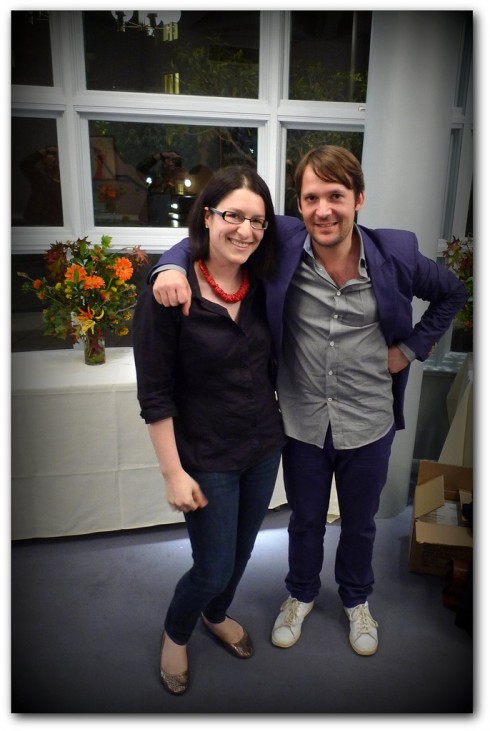
Noma: Time and Place in Nordic Cuisine (Phaidon Press, $49.95) by René Redzepi, www.phaidon.com
by Sam Tackeff | Sep 19, 2010 | Books, Challenge
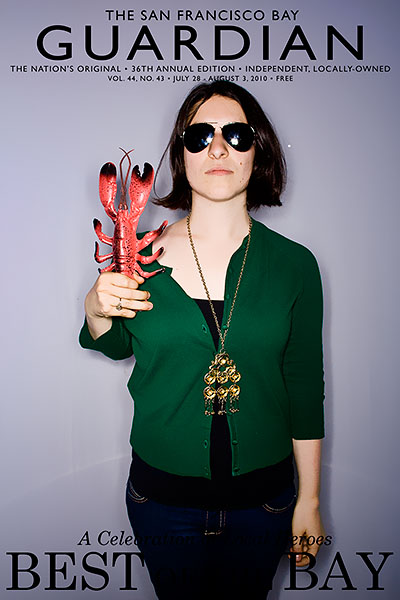
There is nothing quite like a little forced introspection to make you sit down and realize that you’ve had one of the most jam-packed years of your life. (Literally, lots of jam.) In this case, a competition — Foodbuzz’s Project Food Blog is the name of the game. Their first challenge requires me to define why I should be the Next Food Blog Star. Perhaps I should start be re-introducing myself to them, and to you.
I’m Samantha. And I love food.
Two years ago I needed a change of scenery and decided to move three thousand miles from the comfort of New Hampshire to bustling San Francisco. To be honest, this decision was probably made years earlier when I first watched the film Mrs. Doubtfire. Few things live up to the wide eyed optimism of a seven year old, but San Francisco held up its end of the bargain. I love it here.
Continuing with the spirit of reinventing myself, I started a food blog upon my arrival.
Little did I know where it would lead me. Shortly after joining Foodbuzz, I participated in Foodbuzz 24,24,24 and got an amazing dream meal at chef Chris Cosentino’s Incanto. This connected me to an internship at a Food P.R. firm. I started working with chefs and restaurants on recipe organization, development and testing, and fell in love with all the hard work behind creating a dining experience. Okay, truthfully this love started when I became a stagiere in a local restaurant at the age of 12.
Somewhere along the line I also became the research assistant and recipe tester on a cookbook by “Jam it, Pickle it, Cure it” author Karen Solomon (see, lots of jam). I became involved (re: obsessed) with Omnivore Books on Food, and eventually ended up pretty much moving in, thanks to Celia Sack offering me a mercy job. All the while, I took control of my own health, got back into shape, and I went back to school at Integrative Nutrition to become a Health Coach and help others do the same.
And for the sake of full disclosure, I should confess the number of cookbooks I own now well exceeds the bookshelves I own to store them.
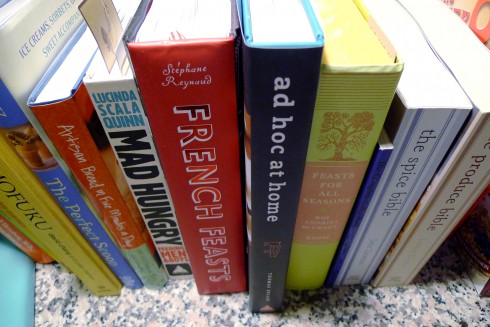
Why do I blog you may ask?
Ultimately, it comes down to the people I get to meet and be truly inspired by. For me, food blogging is not just about the chow, but integrally about those who are a part of it. I realized early on I wanted to share their stories with you. And in many ways, that’s what The Second Lunch has become.
In the past year, I’ve met so many wonderful chefs and insiders of the industry — I truly feel blessed for where my passion for food has led me. For this post, I decided to make a list of some of the folks I’d met, thinking that I’d get a good paragraph out of it. I did not expect this brick wall of superstars. This shocks me every time I glance down at it.
The short list includes: the wonderful folks from Big Sur Bakery, Polly Adema, Arthur Allen, Nate Appleman, Rose Levy Beranbaum, Ed Behr, Amy Besa, John Besh, Carole Bloom, Mark Bittman, Kim Boyce, Bruce & Eric Bromberg, Frank Bruni, Novella Carpenter, Mark Stewart Cassidy, David Chang, Nan Chase, Anita Chu, Andrew Coe, Langdon Cook, Chris Cosentino, Temra Costa, Elizabeth Crawford, Dave Cruz, Tod Davies, Penny De Los Santos,Tracy Des Jardins, Elan Drucker and Brett Emerson, Tara Duggan, Gordon Edgar, Elizabeth Falkner, Sarah Max Feldner, Jeremy Fox, Zoe Francois & Dr. Jeff Hertzberg, Fran Gage, Marcia Gagliardi, Anna Getty, Barbara Ghazarian, Darra Goldstein, Evan Goldstein, Joyce Goldstein, William Grimes, Giuliano Hazan, Dierdre Heeken and Caleb Barber, Jaden Hair, Pauli Halstead, Gerald Hirigoyen, Fergus Henderson, Lauren Hoover, Dianne Jacob, Madhur Jaffrey, Michael Kalanty, Niloufer Ichaporia King, Thomas Keller, Shelly Lindgren, David Lebovitz, Matt Lewis & Renato Poliafito of Baked, Barbara Lynch, Kermit Lynch, Deborah Madison, Jacqueline Mallorca, Harold McGee, Nancy Mehagian, Dr. Daphne Miller, Kate Moses, Marion Nestle, Cynthia Nims, Andrea Nguyen, Barbara Passino, Greg Patent, Cindy Pawlcyn, Georgia Pellegrini, James Peterson, Gayle Pirie, Michael Pollan, Michael Recchiuti, Peter Reinhart, John Relihan, Sara Remington, Tori Ritchie, Chad Robertson & Liz Pruitt, Lorna Sass, Rachel Saunders, Jennie Schacht, Lisa Schwartz, Kim Severson, Andrew Smith, Karen Solomon, Andrew Swallow, Heidi Swanson, Michael Symon, David Tanis, Pim Techamuanvivit, Corinne Trang, Patricia Unterman, Alice Waters, Max Watman, Tara Austen Weaver, Bruce Weinstein & Mark Scarbrough, Ari Weinzweig, Joanne Weir, Laura Werlin, Kathy Wiley, Victoria Wise, Molly Wizenberg, Paula Wolfert, Scott Youkilis, Grace Young, and Jane Ziegelman – Not to mention the hundreds of other food lovers that I’ve had the pleasure to meet over the past two years. (They would fill another post in itself). And I already know I’m forgetting some wonderful people on this list.
And that’s only in the past year. In the next month I’m going to add Rene Redzepi, Tyler Florence, Michael Chiarello, Dorie Greenspan, Jordan McKay, and Diana Kennedy to that list. And who knows who else?
* * *
Just incase you need another reason to push me onto the next round, here are several awkward and embarrassing photos from my childhood revolving around food. From top left: The taste tester, baking cookies with Sarah and Sara, hugging the Mauna Loa Macadamia Nut, and picking apples from a tree.
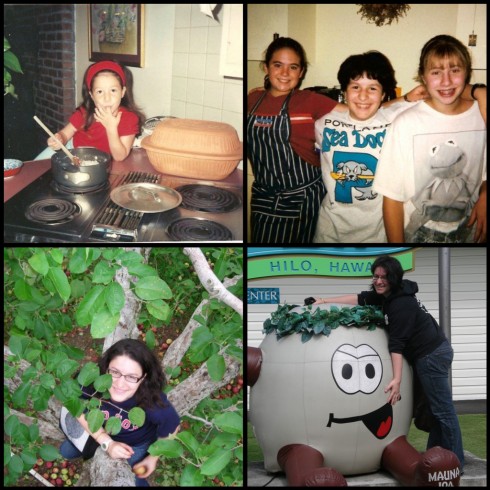
Mostly though, I blog because I love it here. I love being part of a greater community who cares just as much as I do, and doesn’t bat an eye when I whip out a camera at dinner and debate the origin of our meal with my dining companions, purchase another cookbook I don’t have space for because I don’t want to deprive myself of knowledge, wait an hour in line for crispy pork skin because well, it’s crispy pork skin, or wade through thousands of hungry hippies at the farmers market for the perfect summer peach.
Yes, my name is Samantha and I love food.
But equally, I love everything that surrounds it.


























